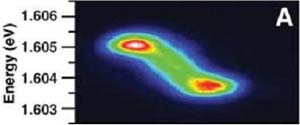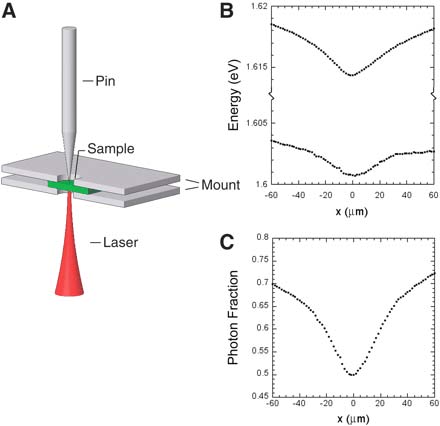Physicists confirm the existence of polariton condensation state
American physicists say they witness a unique combination of a Bose-Einstein condensate (Bose-Einstein condensate - BEC) in a system of cooled particles called " polarition ". Although similar claims have been published before, other researchers in the field are skeptical that this combination is an effect of the laser beam used to create polaritons, meaning is the uncertain system is condensed.
This new experiment completely eliminated doubts by accumulating polaritons from laser beams (see more details in Science 316, 1007).
 First created in 1995 from rubidium vapor, the Bose-Einstein condensate (BEC) is a system in which a large number of bosons (particles with integer spin) grow in a state The basic state is the same. This allows bosons to represent their random classical properties and move as a coherent, and highly significant, state for studies of quantum effects such as superconductivity in a macro system. tissue. The problem here is that state changes usually occur only at very low temperatures, near absolute zero.
First created in 1995 from rubidium vapor, the Bose-Einstein condensate (BEC) is a system in which a large number of bosons (particles with integer spin) grow in a state The basic state is the same. This allows bosons to represent their random classical properties and move as a coherent, and highly significant, state for studies of quantum effects such as superconductivity in a macro system. tissue. The problem here is that state changes usually occur only at very low temperatures, near absolute zero.
However, polaritons - bosons consisting of a pair of electrons - holes and a photon are thousands of times lighter than rubidium atoms, which in turn can create a BEC state at much higher temperatures. The first assertion of this condensation was published in 2006 when Jacek Kasprzak (Joseph Fourier University, Grenoble, France) joined Swiss and British colleagues using a steady increase of laser beams. The density of polaritons in a semiconductor sphere is kept at a relatively high temperature of 19 K.
They observed that above a critical density, polaritons began to exhibit the combined properties of the BEC state (see more details in Nature 443 409). Some other researchers in the field suspect that polaritons are in BEC true state, but because this property can only be observed in an area stimulated by a laser beam that itself has That's right.

Figure 1. Layout diagram of polariton trap system (Science 316, 1007).
And to solve this problem, David Snoke's team at Pittsburgh University and colleagues at Bell Laboratories (USA) created a similar system in which polaritons are produced by laser beams later. move away from laser excitation . This is accomplished by a small pin of 50 microns across, to create a heterogeneous stress on the microspheres, which means creating a trap to accumulate polaritons. And in this system, the BEC state is only achieved at temperatures as low as 4.2 K.
Although this temperature is much lower than the 19 K temperature announced by Kasprzak's group, Snoke told Physics Web that after the publication of this work, the team created this phenomenon at temperatures as high as 32 K: "There are hundreds of reasons to hope that we can reach higher and higher temperatures . although we cannot assume that we can reach room temperature but over 100K is not impossible. in our ability " .
Furthermore, microspheres (or microcavities) are produced by common GaAs semiconductors in the same trap system used in atomic gases that can easily be made for other research groups. .

Figure 2. Momentum distribution of polaritons (Science 316, 1007).
However, there are still some doubts as to whether the Snoke group's system is a BEC state in traditional trends because polaritons have a relatively short life span that can only be reached by states. Standard balance."Some people want to limit the use of the BEC concept to a system in real equilibrium," Snoke said. "On the other hand, there are others who want to generalize them in a mixed system. including lasers, in fact, it is a question of a terminology rather than ".
The Doctrine of Independence
- NASA created a new physical state
- Machine creates drinking water from moisture in the air
- Mission refocused gravity
- Confirm the existence of the 117th chemical element
- Understand how to correct the concept: 'Garlic except evil spirits'?
- Simple experiments create strange matter state
- There is a solution for neutrinos
- The top American doctor believes in
- Evidence of the Higgs boson at Fermilab
- Simple and easy to understand explanation of the existence of each individual in this world
- The truth about hypnosis
- Gravitational waves can reveal the existence of parallel universes
 Daily use inventions come from universities
Daily use inventions come from universities Special weight loss device helps prevent appetite
Special weight loss device helps prevent appetite 8 inventors were killed by their own inventions
8 inventors were killed by their own inventions Iran invented a motor car powered by water
Iran invented a motor car powered by water